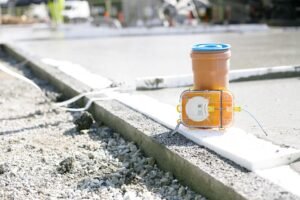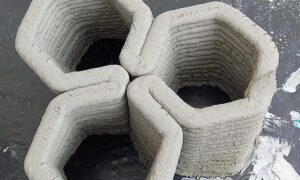In a groundbreaking development for the construction industry, a novel “smart concrete” technology has been recognized as a top innovation, signaling a potential revolution in how we build and maintain our infrastructure. This cutting-edge material, developed by researchers at Purdue University, is not your ordinary concrete mix. Rather, it represents a leap forward in construction technology, offering the ability to communicate with engineers about its strength, weaknesses, and need for repair.
The innovation behind this smart concrete lies in its ability to provide real-time data on its condition. Embedded sensors within the concrete mixture allow it to transmit information directly to engineers via a smartphone app.This means that those responsible for maintaining our roads, bridges, and buildings can receive instant updates on the concrete’s status, from the moment it’s poured to years down the line when wear and tear might become an issue.
What sets this smart concrete apart is its potential to dramatically reduce traffic congestion caused by infrastructure repairs. Consider this: on an annual basis, traffic jams resulting from road work have wasted a staggering 4 billion hours and 3 billion gallons of gas. This is largely due to our limited understanding of infrastructure conditions, often leading to unneeded or poorly timed repairs.With smart concrete, however, we’re looking at a future where road maintenance can be precisely targeted and timed, minimizing disruptions to traffic flow.
The technology works by incorporating sensors into the concrete mix during the construction process. These sensors are capable of detecting a range of significant factors, including temperature, moisture content, and strain. As the concrete cures, it can alert engineers when it has reached its maximum strength, allowing for more efficient project timelines.Later in its lifecycle, if the concrete begins to degrade or develop weaknesses, the sensors can provide early warnings, enabling preemptive repairs before more serious damage occurs.
This innovation isn’t just about convenience; it’s about safety and sustainability too. By allowing for more timely and targeted maintenance, smart concrete can help extend the lifespan of our infrastructure. This means fewer resources used for repairs and replacements, contributing to a more sustainable approach to construction and urban development.
The potential applications for this technology are vast. Imagine highways that can tell us exactly where repairs are needed, bridges that can alert engineers to structural weaknesses before they become perilous, or building foundations that can provide constant updates on their integrity. This level of insight into our built surroundings could revolutionize how we approach urban planning and infrastructure management.
Moreover, the smart concrete technology aligns perfectly with the growing trend towards smart cities. As urban areas increasingly rely on data and interconnected systems to improve efficiency and quality of life, smart concrete could play a crucial role in creating safer, more resilient urban environments. The ability to monitor the health of buildings and infrastructure in real-time could be a game-changer for city planners and emergency responders alike.
The recognition of this technology as a top innovation comes from Fast Company magazine, which included it in their list of Next Big Things in Tech. This accolade is particularly noteworthy as Purdue University stands out as the only academic institution on a list dominated by large corporations and tech startups. This recognition not only validates the potential of smart concrete but also highlights the crucial role that university research plays in driving technological innovation.
The journey of smart concrete from laboratory to real-world submission is already underway. Prototypes of the sensors have been in place on Indiana highways as 2019, thanks to partnerships between Purdue and the Indiana Department of Transportation. The success of these initial trials has led to increased interest, with seven other states joining the project through a Federal Highway Administration nationwide pooled fund.
To further accelerate the adoption of this technology, the lead researcher, Professor Luna Lu, has founded a startup called WaveLogix. This company focuses on Internet of Things sensing systems for infrastructure monitoring, aiming to bring smart concrete technology to market more quickly. The startup has already received support from the National Science Foundation and recognition from the American Society of Civil Engineers, indicating strong industry interest in the potential of this innovation.
As we look to the future, the implications of smart concrete technology extend far beyond just roads and bridges. This innovation could pave the way for a new era of intelligent infrastructure, where our built environment becomes an active participant in its own maintenance and improvement.From reducing traffic congestion and improving road safety to enhancing the longevity of our buildings and bridges, smart concrete represents a significant step forward in how we construct and manage our world.
the recognition of smart concrete as a top innovation marks an exciting moment in the evolution of construction technology. As we continue to face challenges related to aging infrastructure, urban growth, and sustainability, innovations like smart concrete offer hope for more efficient, safer, and longer-lasting buildings and roadways.With ongoing research and development, we may soon see a world where our infrastructure is not just static and silent, but intelligent and communicative, working alongside us to create better, smarter cities for the future.









